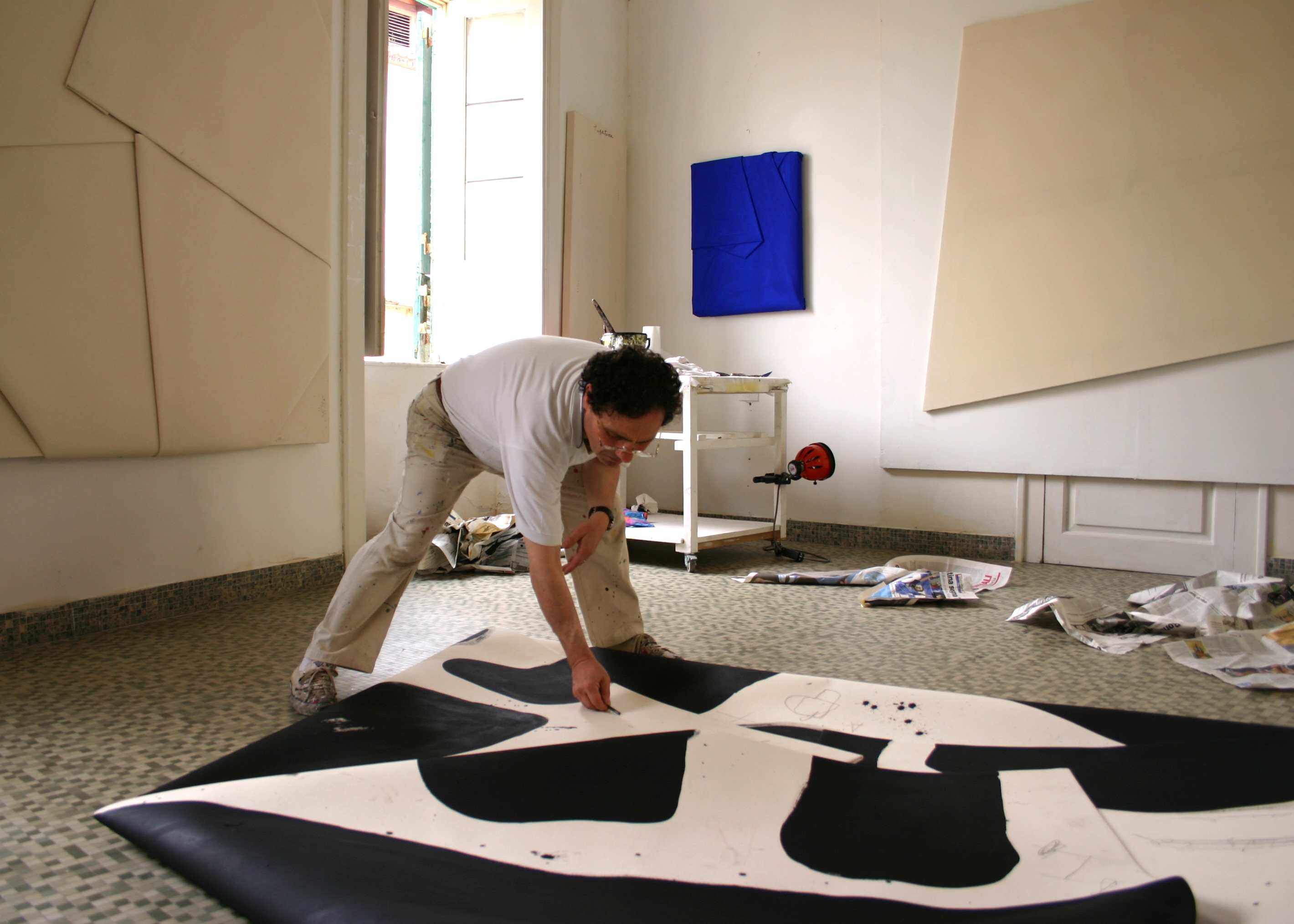
Cesare Berlingeri opens in Miami a great season of Italian Art

From April 19 to May 19 Valli Art Gallery - 1924 N Miami Ave, Miami. From April 20, May 19 General Consulate of Italy - 4000 Ponce De Leon Blvd # 590, Coral Gables. From 20 April at 3.30pm University of Miami - 320 S Dixie Hwy, Coral Gables
With a double exhibition and a lecture at the University of Miami, Cesare Berlingeri opens a great season of figurative art in one of the more comfortable and attractive American cities for the Italian culture.
On April 19th the Italian artist who has gone through the most important experiences of the Italian contemporary art of the second half of the twentieth century, will open his retrospective at Valli Art Gallery in Wynwood. In the afternoon of April 20th he will meet students and teachers of the Faculty of Arts and Sciences, and in the evening he will present his creative work at the Italian Consulate.
To support the project, an important monograph will be published by "Prearo", with a preface by Tommaso Trini and curated by Maurizio Vanni. The preview of the publication will be presented during the event. The book, with the support of "Spirale di idee" and "Art Elite", will be the first step in the creation of the General Catalog of the Master Cesare Berlingeri.
Thanks to the support of the GeneralConsul Gloria Bellelli and the collaboration of the professor GiovanniAccolla from the University of Miami, the season program of Valli Art will continue with a research aimed to enhance the Italian art dedicated to major projects for Italian Masters, such as Mimmo Rotella, Giosetta Fioroni, Michelangelo Pistoletto, and contemporary artists such as Chiara Dynys.
The aim of Valli Art Gallery is to acquire a social role in the city of Miami and become an important reference for the Italian art in the Unites States.
THE EXTENSION OF FOLDING
Understanding Cesare Berlingeri’sworksdoes not require the aid of a metaphor and a simple literal interpretation does not cover it either. Not even if I say: their total motility is like the waves of the sea; or: they open out like a wing. In fact, their folds really form pictorial bodies: others really are shaped like waves: and for the most part, they really do make winged structures. And thus critical discourse draws on resemblances generated by the experience of our senses, and not by metaphors, which are rhetorical figures of speech used to shift meaning. These are extensions structured by nature and not by man. And here they are discussed along with other previously unpublished comments as the opportunity to view these works extends to the United States.
Berlingeri creates paintings folded in from the outside and extended inside, which branch into several linguistic extensions because his art is anthropological without being excessively anthropocentric.
The folded or wrapped pieces remind us of the garden that forks into a thousand paths in a famous short story by Jorge Luis Borges – and that’s a metaphor. Their formal sequence is more precisely described as bodily acts that change into paintings that change into objects, branching - literally - into the completeness of performance, sculpture, and painting. And this belongs in a longstanding repertoire of modernist works that include folds, like Picasso’s collages, the psychic automatism of the cadavres exquis rolled out by Breton and his group, and the assemblages of Rauschenberg and Burri; or wrapped in closed and sealed shapes like certain readymades by Duchamp and Man Ray, if not flaunted like the empaquetages of Christo and Piero Manzoni nor yet definitively bound in a kind of protective internment by both Manzoni and Beuys. Nevertheless, we might add that Berlingeri’s folded paintings encompass all previous inflections in a definitive model, a constructional practice that summarizes all past implications in an Aristotelian model. Cesare Berlingeri began folding his canvases more than forty years ago. Initially, the result was fabric volumes soaked in plaster and pure pigments, which took their shape from their curves. Later, layers wrapped around engraved designs, like microcosms closed but not limited by the artist’s act of sealing. More recently, the fabric volumes take the form of human bodies, whose sculptural torsos tend to expand the spaces they occupy and resonate in. The tangible differences that modify the works from one series to the next are evidence that Berlingeri’s folding is a conceptual a priori idea, open to continuous development.
Berlingeri’s paintings are important for more than one reason. First and foremost they introduced a definitive constructional model - the folding of large pieces of fabric soaked in color - into the unlimited repertoire of techniques of pictorial construction. This is an anthropological procedure which here draws on the history of textiles and their use in theater and painting and is now reconnected to its ancestral implications: this is what makes it remarkably original today. His folding makes no attempt to enclose mysterious or significant objects; nor does it limit itself to crumpled folds on flat surfaces. The composition has a conceptual austerity perhaps reminiscent of the chromatic interaction of Colour Field Painting. Berlingeri excels in incisiveness and dynamism - reminding us instead of some of Matisse’s backgrounds, illuminated by a space vibrant. The first of these pieces date back to his early work in the 1970s, and they run throughout his entire oeuvre like background radiation underlying his system of painting, whose experimental tension can be summed up as: how to combine the emotion that truly belongs to color with the intellect that belongs to design? In the early 70s, when painting was almost completely eclipsed by Conceptual Art and Body Art, Berlingeri stubbornly determined to continue painting and chose the strand of minimalist abstraction, born in Italy as
Pittura-Pittura, which developed in parallel with American Neo-geometric and preceded Italian Transavanguardia.
The critical stage in the young artist’s work came towards 1975, firstly with some undulating surfaces and then with the new pieces folded into three-dimensional shapes. In this way, with a single act of wrapping, protection and secrecy, Berlingeri freed himself of the flatness of painting (and the formalist principles advocated by Clement Greenberg), folded the rigidity of the mounted canvas to the curves of the human body and brought peace in the never-ending conflict between design and colour, proving himself to be a master of both.
It was a long-term decision, a forward leap in an age of return to the past. We can easily imagine the skepticism that greeted the presentation of a strange object full of color and curves in 1979, a time when the first figurative paintings of the Transvanguardia were being hoisted as the clever new standards of the post-modern age. Recalling the beginning, Berlingeri shows us the physical genesis of the incipient innovation: “One day I spread a large piece of fabric, seven metres by seven, on the terrace; I prepared it with plaster and glue, took it into the studio and started walking around it, until the desire came to me to make it into something smaller. But I didn’t want to cut that great piece, it would have felt like cutting into a body, so I began to fold it. With every fold, I made exciting discoveries. Its sense wasn’t canceled out, it was taking on an increasingly concise form, accompanying the actions of my arms. And it seemed to contain something. It contained my thoughts, my ideas, my time, my space. And so I realized there was poetry in those folds”.
The monadic deftness of his stroke is characterized by downward motion, as well as by the theater work that occupied Berlingeri for some time as a designer of sets and costumes. It was in theatre that he became inspired by the gestural language of folding enormous backdrops at the end of a show, as the artist recalled in an interview in 1994: “I would watch how an immense starry night could be reduced fold by fold into a bundle eighty centimetres long, into a folded image that was known not only to me - as I’d painted it - but that had been seen as a true thing by many other spectators”.
Since the moment in early 1990 when I first saw one of the folded canvases swollen with blueness, like a bundle of semi-darkness, at the artist’s studio in Taurianova, I have not stopped following them with a passion; apart from anything else, every time I manage to “feel” these folded paintings, even if only with a tactile glance, the haptic sense - active in every one of us - is instinctively stimulated more than by other paintings covered with substances. It’s a singular simultaneous perception that reinforces optical stimulation with the tactile, by means of the multisensory experience known as synaesthesia, which relies on the association inherent in our senses.
In Cesare Berlingeri’s work, this widens to a less common experience of gravitational synaesthesia, so that it involves feelings of weight, falling and fluctuation. Let it be clear that to speak of his creations in terms of gestural volatility, gravity and free fall is not a metaphorical figure of speech, but has a real perceptual response in our sensorium, caused directly by these works.
Tommaso Trini
“In my paintings, made of several overlapping surfaces, the first layer partially or completely obscures the second. It is with this very structure, with its infinite combinations, that the paintings produce radical transformation and present the transition of conceived images, in other words the passage into concealment, the return to the shadows, to darkness.
What’s depicted in these paintings is the disappearance of light itself into light”
(02-04-1994)
Cesare Berlingeri.
SOURCE: Valli Art Gallery
You may be interested
-
In sordina, l’Italia ritorna in scena al Nat...
La presenza italiana a Natpe 2016, la principale fiera Tv per il mercato Latino Americano...
-
Italian Artists Featured at Miami’s Home Des...
Two prominent Italian artists now living in South Florida will be exhibiting their art as...
-
Meet and Greet with the NEW Italian American...
Thursday, february 5 - 6 pmCatering Revolution - NW 440 Peacock Blvd, Port St. Lucie...
-
Ybor City – Florida’s Little Italy
"The people who had lived for centuries in Sicilian villages perched on hilltops for prote...
-
'A piece of my family:' The Southern Italian'...
Hey Foodies! You know their sausage, but how about the classic, mouthwatering flavors of a...
-
'A small New York': Palm Beach to become home...
Miami-born and Italy-raised, jewelry designer and accomplished equestrian Lucrezia Buccell...
-
'Best putting round ever' lifts Molinari to B...
Francesco Molinari clinched a two-stroke victory at the Arnold Palmer Invitational when he...
-
'Cancer just got their ass kicked': After bei...
Dick Vitale stares at the TV wide-eyed, resting his lower back on the couch to relieve sor...










